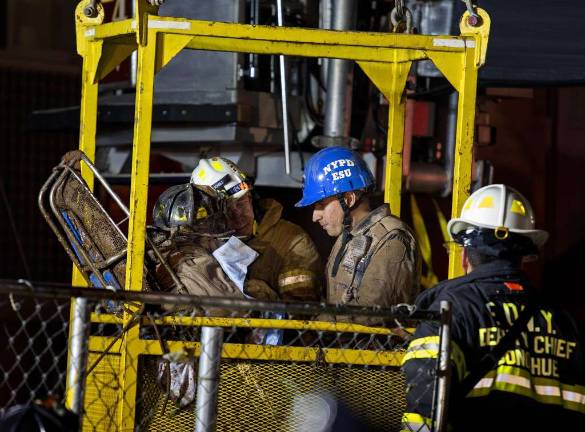How Safe is the Second Avenue Subway?

An accident last week left a construction worker stuck in a pit of mud and lucky to be alive. What does this incident tell us about the safety of the massive project? Last Tuesday, New Yorkers held their breaths as FDNY workers spent four hours rescuing a 2nd Avenue subway construction worker stuck in the mud up to his chest under 2nd Avenue and 95th Street. The good news is, the worker, Joseph Barone, a 27-year construction veteran from the Local 731 union, survived with only a few bruises and a night in the hospital to recover from a bout of hypothermia. Since then, MTA has shut down the work area, pending an investigation into the incident. But just how safe is it to dig in the dark, cavernous tunnels under the city? According to the MTA, since the construction of the 2nd Avenue subway began in 1929, there have been zero deaths. "It's a miracle that more workers don't get hurt, because a lot of what we do is very dangerous," said Richard Fitzsimmons, the business manager of Local 147 Union, the main union for the sandhogs, the nickname for underground construction workers. "Each individual removes so much earth. Just by knowing the work that's been done, and the history, it's astounding." The danger of the sandhog profession felt real that night, as around 8:30 p.m., Joseph Barone got his foot caught in a welding machine, and stepped off of the wooden platforms protecting workers from the quicksand-like mud. As soon as Barone got stuck, his fellow sandhogs worked to stop him from sinking. Authorities came shortly thereafter, and used a crane to lift Barone out of the mud. Sometime after midnight, he was freed, and a crisis was averted. (http://nypress.com/wp-content/uploads/2013/03/MTA-Worker-Rescued-2_Photo-courtesy-MTA_Patrick-Cashin.jpg) Charles Cannon, who has been a sandhog for 42 years, and worked on the 2nd Avenue subway line a year and a half ago, said that he remembered a similar incident when he was working underground in Brooklyn some years ago, when his co-worker had gotten stuck in the mud. "You're talking to the man one second and the next he got buried, and you're not sure where he might even be," recalled Cannon of the terrifying situation. "When you have a situation like that, there's a case of suffocation, there's weight around your body alone everytime you breathe in and exhale it wont let you breathe in as much, your lungs can't expand." Cannon explained that in a situation like Barone's, you have to stand very still, because panicking and moving around will only make the body sink faster. During that accident years ago in Brooklyn, he and his fellow sandhogs were able to dig the victim out, but that doesn't always happen. "I've seen too many accidents occur. I don't want to see anymore; I've even seen people pass away right in front of me," said Cannon. In fact, the underground construction work of sandhogs is considered to be the heaviest, and therefore the most dangerous of all the types of construction work, said Richard Fitzsimmons. Despite the inherent dangers of the profession, the 2nd Avenue Subway work has had a good record. In addition to the clean fatality record, only 2.1 accidents occur per 200,000 man hours, which is well below the Department of Labor standards, according to the MTA. Fitzsimmons said that this is most likely due to better technology, better insurance incentives and tighter safety requirements. He said that, for instance, after several workers had their legs severed on the job, the union implemented the job of a brakee, who would stay with the machinery, to turn on the brakes in case something went wrong. Plus, he said, insurance companies give premium discounts to companies that work without accidents, so the union holds a lot of safety classes and medical training for their workers. "In the long run, simply, it's going to save lives, and save us a lot of money," said Fitzsimmons. Cannon said that he attributes the lack of fatalities to newer and better safety technology, like harnesses with bungee cords on the back. If you fall, he says, the harness will not only catch you, but will ease you down so that you don't throw your back out. Construction workers are decked out in protection gear: hard hats, ear plugs, work boots, barrier creams and harness belts. "There's danger everywhere," said Cannon. "We all watch out for each other; you have to do that." But even with a slew of safety precautions and backups, Cannon said that going down into the darkness as a rookie can be terrifying. There's always a danger of falling, being crushed, or even breathing in dangerous particles. Plus, Cannon said, the primal fear of claustrophobia is often present. "It's very tight quarters," he said. "I've seen people take the elevator ride down 600-900 feet down when they get down they won't get out of the elevator. They say 'take me back up'; it's overpowering." The invisible grueling work by sandhogs on the 2nd Avenue subway is expected to be completed by 2016. At which time, "the subway line that time forgot" will finally open to the public. "When I go into those tunnels, it's nothing short of majestic, and when it's finally done, it's really going to be something," said Richard Fitzsimmons.